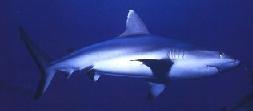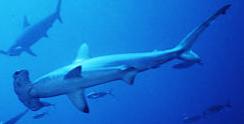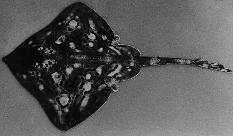Chondricthyes
Reminder: Clicking on the picture will take you to the site where I originally found it.
 Chondricthyes means cartilage-fish. This class includes fish such as the sharks, skates and rays. You'll find that, even though the skeleton of the chondricthyes is made of cartilage, they're tough animals.
Chondricthyes means cartilage-fish. This class includes fish such as the sharks, skates and rays. You'll find that, even though the skeleton of the chondricthyes is made of cartilage, they're tough animals.
The characteristics of the cartillagenous fish are pretty cool. -
cartilaginous skeleton
- teeth not fused to jaw
- teeth replaced in rows
- unsegmented epidermal fin rays
- single, ventral nostrils on each side of head
- spiral valve intestine
- claspers on pelvic fins of males
You'll notice that the teeth of the chondricthyes are rather specialized. If you've ever seen a shark's jaw, you understand what is meant by the teeth being in rows. Sharks have a great number of teeth, but they aren't attached formly to the jaw. They tend to break off easily and need to be replaced often. They continually grow new teeth throughout their lives.
There are many types of chondrichthyes. Sharks are the most familiar, but rays, like the large manta ray, are here too. This class is also noted for unusually shaped heads. Sawfish and hammerheads are among these. The body plans for chondricthyes are diverse.
When discussing the classification of chondrichthyes, let it be known there are two living orders of cartilage fish. -
the Elasmobranchii (sharks, skates and rays)
- the Holocephali (the chimaeras, such as the ratfish and elephant fish)
Let's take a closer look at these.
Elasmobranchii
 Sharks are among the most successful of marine predators. They seem to rule the oceans. Actually, sharks are far more diverse than you'd guess. Some of the sharks, the whale sharks, are enormous, but they only eat plankton and tiny fish. They aren't the cold-blooded killers that hollywood led us to believe.
Sharks are among the most successful of marine predators. They seem to rule the oceans. Actually, sharks are far more diverse than you'd guess. Some of the sharks, the whale sharks, are enormous, but they only eat plankton and tiny fish. They aren't the cold-blooded killers that hollywood led us to believe.
There are many diverse sharks. There are very small sharks, very large, and very unusual. There is a sawshark, which is NOT the same as a sawfish. Actually, there are over 350 types of sharks, including the tiger, nurse, blue, and the dogfish. And what about the great killer? You would be talking about the great white shark. This is the shark whose behavior was exaggerated for the movie Jaws, and completely warped for the sequels.
 Possibly my favorite shark would be the hammerhead. These sharks are even more fun to see in person than on the computer. At least I can offer you a video with a shark. Most of these sharks are not dangerous to humans, but a few are.
Possibly my favorite shark would be the hammerhead. These sharks are even more fun to see in person than on the computer. At least I can offer you a video with a shark. Most of these sharks are not dangerous to humans, but a few are.
Sharks don't like to eat humans. Even the great white shark has never been known to eat humans, only bite them. We invade their hunting grounds and, to sharks, look a little like seals or other prey. They bite and then, after tasting the nasty human flesh, let go. Sharks don't kill many people at all. Dogs are more ferocious.
 Also, as part of the elasmobranchii are the skates and rays. These creatures look a bit alike, but there are many differences between the two.
Biggest difference? Skates lay eggs and rays give birth to live young. Skates are also built for more movement while rays are content to spend most of their lives on the shallow sea-floor, picking up food where they can.
Also, as part of the elasmobranchii are the skates and rays. These creatures look a bit alike, but there are many differences between the two.
Biggest difference? Skates lay eggs and rays give birth to live young. Skates are also built for more movement while rays are content to spend most of their lives on the shallow sea-floor, picking up food where they can.
Rays are the more familiar of these animals. The manta ray is huge, and may be twenty feet across. Even more famous is the sting ray. They have a stinger in their tails and can inflict injury.
Have you ever seen a sawfish? Real sawfish are rays with a modified rostrum (nose). They son't saw wood with that shout, but stir up critters on shallow ocean floors. They don't attack humans and are quite harmless. Generally speaking, rays are not hostile creatures, and even sting rays will only sting if stepped on or threatened.
 Skates are pretty placid organisms as well. They resemble rays quite strongly, but they do lay eggs.
Skates are pretty placid organisms as well. They resemble rays quite strongly, but they do lay eggs.
The egg case of the skate is nicknamed a mermaid's purse. It has an unusual shape, similar to a rectangle with spikes on the corners. Inside the case a single skate grows. Make sure you take some time to look at these fun creatures.
Holocephali
 Holocephali is such an impersonal name. How about something kinder, like a ratfish? Actually, belonging to this class are the chimeras, which includes the ratfish, elephant fish, spookfish and rabbit fish.
Holocephali is such an impersonal name. How about something kinder, like a ratfish? Actually, belonging to this class are the chimeras, which includes the ratfish, elephant fish, spookfish and rabbit fish.
The chimaeras are pretty much an unusual-looking crowd. Little is known about their biology. It is said that these are the "neglected" fish. Perhaps they are. This much we know:
- Chimeras are mostly scale less, with a spine at the base of the dorsal fin being a modified scale
- An operculum (gill cover) is present
- The males have a cephalic (head) clasper (presumably, this must help with mating)
- Their jaws are firmly attached to the cranium, unlike sharks, who have separate jaws.
Even with all that, there is a lot we don't know.
Back to the Chordate page, or
to the overview.
 Chondricthyes means cartilage-fish. This class includes fish such as the sharks, skates and rays. You'll find that, even though the skeleton of the chondricthyes is made of cartilage, they're tough animals.
Chondricthyes means cartilage-fish. This class includes fish such as the sharks, skates and rays. You'll find that, even though the skeleton of the chondricthyes is made of cartilage, they're tough animals. Sharks are among the most successful of marine predators. They seem to rule the oceans. Actually, sharks are far more diverse than you'd guess. Some of the sharks, the whale sharks, are enormous, but they only eat plankton and tiny fish. They aren't the cold-blooded killers that hollywood led us to believe.
Sharks are among the most successful of marine predators. They seem to rule the oceans. Actually, sharks are far more diverse than you'd guess. Some of the sharks, the whale sharks, are enormous, but they only eat plankton and tiny fish. They aren't the cold-blooded killers that hollywood led us to believe. Possibly my favorite shark would be the hammerhead. These sharks are even more fun to see in person than on the computer. At least I can offer you a video with a shark. Most of these sharks are not dangerous to humans, but a few are.
Possibly my favorite shark would be the hammerhead. These sharks are even more fun to see in person than on the computer. At least I can offer you a video with a shark. Most of these sharks are not dangerous to humans, but a few are.  Also, as part of the elasmobranchii are the skates and rays. These creatures look a bit alike, but there are many differences between the two.
Biggest difference? Skates lay eggs and rays give birth to live young. Skates are also built for more movement while rays are content to spend most of their lives on the shallow sea-floor, picking up food where they can.
Also, as part of the elasmobranchii are the skates and rays. These creatures look a bit alike, but there are many differences between the two.
Biggest difference? Skates lay eggs and rays give birth to live young. Skates are also built for more movement while rays are content to spend most of their lives on the shallow sea-floor, picking up food where they can.
 Skates are pretty placid organisms as well. They resemble rays quite strongly, but they do lay eggs.
Skates are pretty placid organisms as well. They resemble rays quite strongly, but they do lay eggs. Holocephali is such an impersonal name. How about something kinder, like a ratfish? Actually, belonging to this class are the chimeras, which includes the ratfish, elephant fish, spookfish and rabbit fish.
Holocephali is such an impersonal name. How about something kinder, like a ratfish? Actually, belonging to this class are the chimeras, which includes the ratfish, elephant fish, spookfish and rabbit fish.